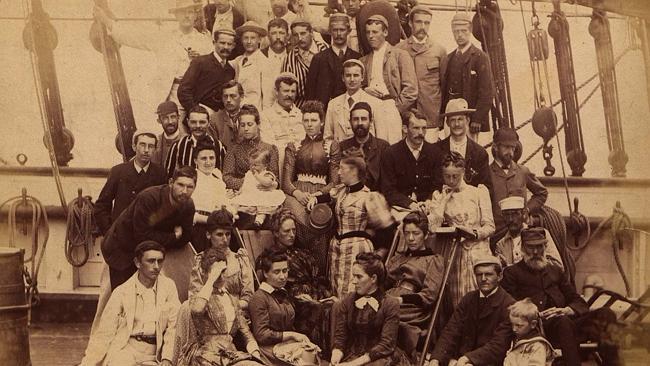Voyage to Australia was anything but plain sailing for earliest travellers
Life aboard ship on the voyage from England to Australia in the 19th and early 20th century was a gruelling endurance test

Today in History
Don't miss out on the headlines from Today in History. Followed categories will be added to My News.
Illness, terrible food, cramped quarters and day after endless day with nothing to do. If today’s long- haul flight from England to Australia seems gruelling, spare a thought for our forebears who travelled here in the ages of sail and steam.
Conditions on board ships were horribly tough, not just for the convicts carted here in the first years of the colony but also for those who chose to migrate or visit in later decades.
Despite the miserable conditions, passengers found ways to amuse themselves, even if that simply involved recording every aspect of their journey for posterity.
University of Sydney is currently displaying rare objects relating to those voyages in its exhibition Circumstances Of Interest. Offering rich insights into the life of these intrepid travellers are travel diaries, journals and paintings dating back to as early as 1823 when convicts were still being transported to Australia.
There were few creature comforts on board the transports, for convicts, officers or crew. Convicts had the worst of it, squeezed into small barred enclosures below decks, sleeping on hammocks, with buckets for lavatories, no privacy and unappetising food. Occasionally they were allowed on deck for some exercise and for the cells to be cleaned out. When this didn’t happen, disease would spread and deaths aboard convict ships were not uncommon.
The first free passengers to come here from England were traders, adventurers and explorers who also travelled under spartan conditions, subsisting mainly on rations such as salted meat or pease (dried peas reconstituted as a kind of porridge).
The first free settlers arrived in 1793 aboard the Bellona, which was also carrying convicts. By the beginning of the 19th century more ships carried paying passengers without convicts, but the comfort had not vastly improved. Passenger ships were generally divided into classes, so those who could afford to pay for first-class cabins could enjoy their own quarters, buy better food, take servants and section themselves off from poorer passengers. Second-class passengers were slightly worse off than first-class, although on some ships they shared rooms with up to 100 other passengers.
Passengers in the lowest class, known as steerage, lived in cramped shared spaces, with no privacy and hammocks instead of beds. It was not far removed from the convict accommodation, apart from the lack of bars and better levels of hygiene.
Despite their comparative luxury, even those in first class complained, says Circumstances Of Interest curator Fiona Berry. The diaries reveal concerns across all three classes were complaints about fellow passengers, illness aboard and the weather.
Illness was regular, with many diary entries mentioning the first death on board. In the more cramped sections illness spread quickly and although first-class passengers could be untouched “sea sickness affected people no matter what class”. Theft was another problem, particularly food.
To alleviate boredom and create a distraction from the terrible conditions passengers played pranks on each other. One passenger describes how he kept finding himself pulled from his bunk by a rope tied around his leg.
Musical passengers would seek out others who could sing or play instruments then organise concerts for which they made their own concert programs. Games included cricket as well as less active but no less boisterous games. There are diary accounts by passengers complaining about being kept awake by noisy card players.
Many took to writing plays to be performed on board and poetry for recitals. Sketching and painting were also popular distractions. Although most were migrants sailing out of necessity, some voyages were recreational. One of the diaries details a couple on their honeymoon.
Circumstances Of Interest, Level 3, Fisher Library, until December 31, news.library.usyd.edu.au/rare-books-exhibition-circumstances-of-interest
Originally published as Voyage to Australia was anything but plain sailing for earliest travellers



